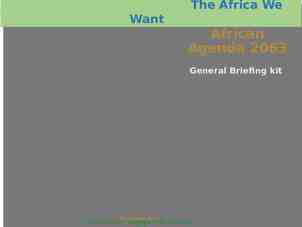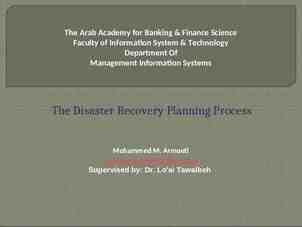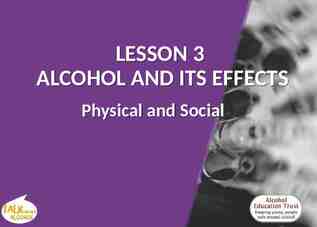Introducing FSA’s Budget and Performance Management System (BPMS) with
31 Slides4.43 MB

Introducing FSA’s Budget and Performance Management System (BPMS) with a New Strategic Plan for better decision making and accountability to citizens! April 14, 2005 Karen Malkin, Director Strategic Performance and Evaluation Staff Dennis Taitano, Director Budget Division

What is the Farm Service Agency? Farm Service Agency (FSA) is a major agency of the U.S. Department of Agriculture. FSA was created in 1994 by incorporating the commodity and conservation programs of the former Agricultural Stabilization and Conservation Service (ASCS) and the lending programs of the Farmers Home Administration (FmHA). Cleveland, 1940 The Agency’s name has changed over the years, however, its relationship with farmers and ranchers dates back to the 1930s. Serving farmers and ranchers is a major component of USDA’s mission. 2

FSA Business Lines FSA delivers a wide variety of programs to over 2.2 million registered agricultural producers. Farm commodity programs Farm credit -- ownership, operating and emergency loans Conservation and environmental programs Emergency and disaster assistance Domestic and international food assistance International export credit programs 3

FSA Programs FSA Programs are legislated by: Farm Bill Annual Appropriations Disaster and Emergency Acts 4

Program Delivery Agricultural producers apply for benefits and service from their local USDA Service Center. FSA has over 2,400 Service Centers nationwide, including local offices in Puerto Rico and Guam. FSA has 51 State Offices, including Puerto Rico. 5

Decentralization & Local Governance FSA workforce 17,000 Federal and nonFederal employees State and local county-elected committees oversee the delivery of FSA programs. Committee system and local governance sets FSA apart. 6

Why is FSA Seeking to Transform? Link program results to budget requests. Dismantle existing “stove pipes.” Streamline business processes. Improve accountability. Align resources effectively. Improve employee engagement. Improve customer service & satisfaction. It’s good business! “Better Performance Makes Sense!” 7

Organizational Issues Facing Agencies Striving to Transform FROM Delivering and Monitoring Outputs Hierarchical Micro-management Working in Stovepipes Protecting Turf Hoarding Knowledge Avoiding Risk Adversarial Labor/Management Relations Avoiding New Technology TO Delivering and Monitoring Results Horizontal (i.e., flatter) Employee Empowerment Working in Matrixed Teams Forming Partnerships Sharing Knowledge Managing Risk Constructive Labor/Management Relations Embracing and Leveraging New Technology 8

What is BPMS? BPMS is management tool to facilitate FSA's transformation to more performance-based, results-focused agency. Links and integrates FSA's budget, cost, and performance management information. Begins with new Fiscal Years 2005 – 2010 Strategic Plan. “What gets measured gets done AND funded!” 9

Key Elements BPMS Strategic Plan Framework Systems & Technology Reporting & Budgeting Performance Management Finance & Accounting Planning & Budgeting Program Management – Program Assessment Rating Tool (PART) Other (e.g., Human Resources, Procurement) Cost & Performance Governance & Accountability Human Capital Plan People – Processes - Systems 10

Budget and Performance Management System 11

BPMS Management Structure FSA Administrator Associate Administrator for Operations and Management Associate Administrator for Programs Director, Office of Business and Program Integration Director, Strategic Performance and Evaluation Staff BPMS Core Team Strategic Performance & Evaluation Staff Director, Co-Chair Budget Director, Co-Chair Senior Managers: Farm Programs Farm Loan Programs Commodity Operations Field Operations External Affairs Civil Rights Key Advisors Information Technology Division Economic and Policy Analysis Staff Financial Management Division Human Resources Division State and County Offices 12

Engaging External Stakeholders Six full-day external stakeholder meetings in Omaha, Sacramento, and Washington, D.C. Input from 250 External Stakeholders: Farmers and ranchers Conservation and environmental groups State and Federal agencies Commodity groups and trade associations Community-based and civil rights organizations 13

Photos Courtesy of USDA & DOI 14

Strategic Goal 3 Conserving Natural Resources and Enhancing the Environment END OUTCOMES END OUTCOME 1 END OUTCOME 2 END OUTCOME 3 END OUTCOME 4 Quality Soil INDICATOR Reduced erosion rates. Quality Water INDICATOR Reduced ground and surface water contamination. Quality Wildlife Habitat INDICATOR Increased populations of targeted species. Quality Air INDICATOR Increased tons of carbon dioxide sequestered. INTERMEDIATE OUTCOMES OBJECTIVE 3.1 OBJECTIVE 3.2 OBJECTIVE 3.3 Improving Conservation Practices PERFORMANCE MEASURES Targeting Lands to Maximize Conservation Benefits PERFORMANCE MEASURES Mitigating Adverse Impacts From Agricultural Production PERFORMANCE MEASURES M1 Increase acres managed under Continuous Conservation Reserve Program (CRP) sign-up. M1 Increase CRP acres of riparian and grass buffers. M1 Maintain or increase % of acres in compliance with highly erodible land and wetland provisions. M2 Increase % of conservation acres with invasive species controls. M2 Increase general sign up acres in priority areas. * Asterisk denotes efficiency measure. M2 Increase % of CCC sites where remediation is implemented. M3 Increase CRP restored wetlands acres. M3 Reduce average processing time of conservation offers through partnerships and technology: - FSA time* - partner time*. PRODUCTS and SERVICES 26

End Outcomes and Indicators Three Societal Strategic Goals – High Level FSA plays a role in achievement of these societal goals, but Agency is not solely responsible for end outcomes. Strategic goals are relevant beyond FSA – USDA and many other agencies and private entities play roles. 16

Example Showing Interagency Responsibilities Strategic Goal 3 Conserving Natural Resources and Enhancing the Environment END OUTCOMES END OUTCOME 1 Quality Soil INDICATOR Reduced erosion rates. END OUTCOME 2 END OUTCOME 3 END OUTCOME 4 Quality Water INDICATOR Reduced ground and surface water contamination. Quality Wildlife Habitat INDICATOR Increased populations of targeted species. Quality Air INDICATOR Increased tons of carbon dioxide sequestered. FEDERAL AGENCIES RESPONSIBLE FOR SUPPORTING EACH OUTCOME FSA FSA FSA FSA Environmental Protection Agency Environmental Protection Agency U.S. Department of the Interior U.S. Department of the Interior Natural Resources Conservation Service Natural Resources Conservation Service Environmental Protection Agency Environmental Protection Agency U.S. Department of the Interior Natural Resources Conservation Service Natural Resources Conservation Service National Oceanic and Atmospheric Administration National Oceanic and Atmospheric Administration Other Government (Federal, State and Local) Agencies and Nongovernmental Organizations 28

End Outcomes and Indicators Indicators with End Outcomes are measured every 3 years by reviewing relevant statistics to see trends. Indicators are not reported with FSA’s Performance Budget. Indicators are not directly linked to individual employee performance. 18

Objectives and Performance Measures Short-Term Results to Accomplish – Intermediate Level FSA can influence the achievement of these Objectives, which can ultimately lead to the accomplishment of end outcomes and strategic goals. Measures with Objectives are reviewed annually or more frequently, when appropriate, by monitoring target levels. Measures are reported with FSA’s Performance Budget. Measures are directly linked to senior managers’ performance. 19

Outputs and Employee Performance Measures Products and services of the Agency. Activities performed by employee that lead to outputs or products and services. Measures set by employee’s manager specifically for employee. Measures linked to employee’s performance. Employee measure falls under Agency’s performance measure. 20

Example: How Do Employees Link to the Strategic Plan? Agency Strategic Goal 3: Conserving Natural Resources and Enhancing the Environment END OUTCOMES AGENCY END OUTCOME 1: Quality Soil INDICATOR 1: Reduced erosion rates. INTERMEDIATE OUTCOMES SENIOR MANAGER PLAN OBJECTIVE 1: Improving Conservation Practices MEASURE 1: Maintain or increase % of acres in compliance with highly erodible land and wetland provisions. PRODUCTS and SERVICES EMPLOYEE PLAN OUTPUT: Spot-checks for Conservation Compliance

From Annual Performance to Strategic Plan Annual Performance EMPLOYEE ACTIVITIES EMPLOYEE PLAN Business processes performed by the employee. Form AD-2000, Performance Plan Agreement and Appraisal. Form AD-2000, Performance Plan Agreement and Appraisal. Example: Processing racial and ethnic minorities direct loans. Example: Mission Results: Goal 1, Objective 1, Measure 3: By 9/30/05, Reduce average processing time for racial and ethnic minorities direct loans to 34 days from FY 04 baseline (3 year average) of 37 days - set for employee. Example: Mission Results: Goal 1, Objective 1, Measure 3: By 9/30/05, Direct Loans and Funds Mgmt. Branch will reduce average processing time for direct loans to 35 days from FY 04 baseline (3 year average) of 37 days - set for office. MID-LEVEL MANAGER PLAN PROGRAM OR OPERATING MEASURES Monitoring progress and achievement based on outputs, products, and services. Example: Program measures such as: Decrease in average processing time for all direct loans to 36 days from FY 04 baseline of 38 days Agency-wide. Note: These measures would be included in an Operational Plan for major program areas. Strategic Plan FSA PERFORMANCE BUDGET/ APP SES/GS 15,14 PLAN An annual detailed plan for the acquisition and use of financial and other resources wherein expenditures are based primarily upon measurable performance. Example: Goal 1, Objective 1, Measure 3: By 9/30/05, Reduce average processing time for all direct and guaranteed loans to 39 days from FY 04 baseline (3 year average) of 40 days Agency-wide. Note: This measurement is for senior mgmt. accountability. FSA OBJECTIVES What results to accomplish by when (shortterm). Example: Goal 1, Objective 1: Improving Access to Capital. FSA END OUTCOMES What results to accomplish by when (longterm). Includes measures, which are directional indicators that will be assessed every 3 years. Example: End Outcomes for Goal 1: Successful Farms and Ranches A Market-Based Agriculture Sector Thriving Agricultural Communities. FSA STRATEGIC GOALS Societal results FSA wants to accomplish. Example: Goal 1: Supporting Productive Farms and Ranches. FSA VISION Description of what FSA is capable of becoming. Vision: A customerdriven agency with diverse and multi-talented work force, dedicated to achieving an economically and environmentally sound future for American Agriculture. FSA MISSION Reason for FSA’s existence. Mission: Equitably servicing all farmers, ranchers, and agriculture partners by delivering effective, efficient agricultural programs for all Americans. Example of outcome: Timely processing of farm loans enables beginning farmers to stay in business. 22

Strategic Goal Linkage - FSA to USDA to FSA OLD NEW FSA FY 01-05 Strategic Plan FSA FY 05-10 Strategic Plan Strategic Goal 1 Provide farm income support to eligible producers, cooperatives, and associations to help improve the economic stability and viability of the agricultural sector and to ensure the production of an adequate and reasonably priced supply of food and fiber. Strategic Goal 3 Assist eligible individuals and families in becoming successful farmers and ranchers. USDA FY 02-07 Strategic Plan Strategic Goal 1 Enhance Economic Opportunities for Agricultural Producers Strategic Goal 4 Strategic Goal 1 Promoting Productive Farms and Ranches Strategic Goal 2 Supporting Secure and Affordable Food and Fiber Supply Improve the effectiveness and efficiency of commodity acquisition, procurement, storage, and distribution activities, and administer the U.S. Warehouse Act (USWA). Strategic Goal 2 Assist agricultural producers and landowners in achieving a high level of stewardship of soil, air, and wildlife resources on America’s farms and ranches while protecting the human and natural environment. Strategic Goal 5 Protect and Enhance the Nation’s Natural Resource Base and Environment Strategic Goal 3 Conserving Natural Resources and Enhancing the Environment 9

FY 2006 President’s Budget Strategic Goal Linkage – FSA to USDA USDA Strategic Goal/Objective USDA Goal 1: Enhance Economic Opportunities for Agricultural Producers FSA Strategic Goal Agency Goal 2: Supporting Secure and Affordable Food and Fiber Supply FSA Strategy Objective 2.2: Income Support Providing Adequate, Programs Secure Storage Capacity that Maintains Commodity Operations Quality Objective Strategic 1.2: Support International Economic Development and Trade Capacity Building USDA Goal 1: Enhance Economic Opportunities for Agricultural Producers USDA Strategic Objective 1.3: Expand Alternative Markets for Agricultural Products and Activities Agency Goal 1: Supporting Productive Farms and Ranches Major Program Areas that Contribute Objective 1.4: Expanding Market Opportunities FSA End Outcome End Outcome 2: Secure Supply of Quality Food and Fiber End Outcome 3: Effective Food Aid Commodity Operations End Outcome 1: Successful Farms and Ranches End Outcome 3: Thriving Agricultural Communities

FY 2006 President’s Budget Strategic Goal Linkage – FSA to USDA, Continued USDA Strategic Goal/Objective USDA Goal 1: Enhance Economic Opportunities for Agricultural Producers FSA Strategic Goal Agency Goal 1: Supporting Productive Farms and Ranches FSA Strategies Objective 1.1: Improving Access to Capital Objective 1.2: Mitigating Market Losses Objective 1.3: Mitigating Losses from Natural Disasters USDA Strategic Objective 1.4: Provide Risk Management and Financial Tools to Farmers and Ranchers Major Program Areas that Contribute Farm Loan Programs Income Support Programs End Outcome 1: Successful Farms and Ranches Disaster Assistance Programs End Outcome 2: A Market-Based Agricultural Sector Conservation Programs Commodity Operations Agency Goal 2: Objective 2.1: Supporting Secure and Supporting Domestic Affordable Food and Fiber Agriculture FSA End Outcome Farm Loan Programs Income Support Programs End Outcome 3: Thriving Agricultural Communities End Outcome 1: Affordable Food and Fiber Disaster Assistance Programs Conservation Programs Commodity Operations USDA Strategic Goal 5: Protect and Enhance the Nation’s Natural Resource Base and Environment USDA Strategic Objective 5.2: Improve Management of Private Lands Agency Goal 3: Conserving Natural Resources and Enhancing the Environment Objective 3.1: Improving Conservation Practices Objective 3.2: Targeting Lands to Maximize Conservation Benefits Objective 3.3: Mitigating Adverse Impacts from Agricultural Production Conservation Programs Farm Loan Programs End Outcome 1: Quality Soil End Outcome 2: Quality Water End Outcome 3: Quality Wildlife Habitat End Outcome 4: Quality Air

SAMPLE Performance Measure Crosswalk FY 06 BPI Goal 1: FY 05 BPI Maintain or reduce loss Goal 3: Direct loan loss rate (%). - Direct loans Goal 3: Guaranteed loan loss rate (%). rates for: - Guaranteed loans Goal 1: Reduce average processing time for: Goal 3: Processing time for direct loans (%). Goal 3: Processing time for guaranteed loans (%). - Direct loans - Guaranteed Loans Goal 1: Increase % of: Goal 3: Loans to beginning and socially disadvantaged farmers (% of total lending). Goal 3: Direct loan delinquency rate (%). - beginning farmers - racial and ethnic minorities, and women farmers financed by FSA. Goal 3: Borrowers graduated from direct loans to guaranteed loans (%).

SAMPLE Performance Measure Crosswalk FY06 BPI BPMS Management Scorecard: Reduce % of skills gaps in mission critical occupations. USDA FY02-07 Strategic Plan Management Initiative 1: Improve human capital management. Reduce average processing time to fill vacancies. Increase % of employees that meet the homeland security training standards. Reduce average time to certify and disburse payments. Management Initiative 2: Improve financial management. Reduce % of erroneous payments. Increase % of material weaknesses that are corrected on schedule. Increase % of transactions completed through a web environment. Increase % of program results and budget requirements that are linked to the FSA Strategic Plan and fully costed. Management Initiative 3: Expand electronic government. Management Initiative 4: Establish budget and performance integration.

BPMS Milestones Department and OMB Approval of Strategic Plan Framework Incorporation of Framework into FY 2006 Performance Budget Linkage of Employee Performance to FY 2005-2010 Strategic Plan Development of BPMS Intranet (internal) and Internet (public) Websites Development of Interim Web-based Performance/Budget Reporting System Release of Draft Strategic Plan for Public Comment Vendor Demonstration of INTEGRATED Web-based Budget, Performance, and Cost Accounting Data System Development & Implementation of INTEGRATED Web-based Performance Reporting System Implementation of Strategic Plan Measure Customer Satisfaction Measure Effectiveness of Partnerships Streamline Business Processes Develop & Implement Tiered Employee Performance System Leverage Resources through Partnerships 28

TRANSFORMATION Challenges Institutes MAJOR cultural change – performance based. Requires integrated change management and will facilitate an integrated process for realigning resources. Requires continued commitment and support from all levels. 29

Questions? Comments? Visit BPMS Internet Site at: http://www.fsa.usda.gov/bpms Please contact us by e-mail at: [email protected] 30

Farm Service Agency 31






